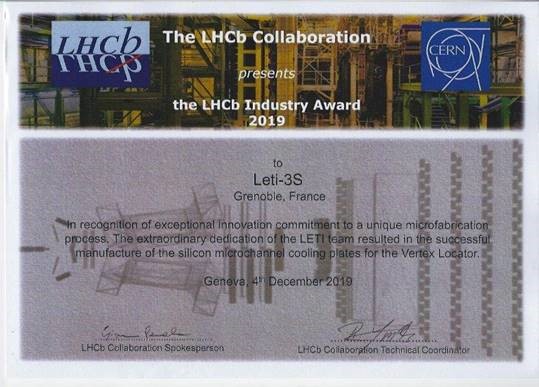Since 2014, CEA-Leti's microfluidic circuits have been used for cooling a particle detector in CERN's NA62 Gigatracker (GTK), one of the underground experiments near Geneva. The silicon pixel detector is used to measure the arrival time and the position of incoming beam particles in the Super Proton Synchrotron, the second-largest particle accelerator at CERN. Building on that success, CEA-Leti is supplying more than 50 micro-coolers for LHCb, one of four experiments in the Large Hadron Collider (LHC), CERN's main ring. This experiment will investigate what happened after the Big Bang that allowed matter to survive and build the universe we live in.
The current two-year upgrade is expected to be completed in January 2021. Recently, CEA-Leti's Silicon Specialty Solutions (Leti 3S) team received CERN's Industry Award for the high quality of the micro-coolers and for the team's "exemplary" collaboration.
LHCb will study a type of particle called a b quark to gain insights into the small asymmetries between matter and antimatter. After the LHCb upgrade, the detector cooled will be only 5 mm from the proton beams being smashed into each other, compared with 8.5 mm previously. The micro-coolers will have to maintain the temperature at -20 °C and operate for 10 years under vacuum and high radiation.
"Leti 3S's micro-cooler circuits were chosen over differing, competing solutions, and in the end it was our technology and its performance in the NA62 project that won the day," said Eric Rouchouze, Leti 3S program manager. "Key differentiators for our micro-coolers are the quality and the strong experience of the bonding processes, and our capacity to innovate on quite new stages, such as dicing of the devices by plasma etching."
Leti's microfluidic circuit is made of a network of microchannels just tens of microns deep produced using a plasma etching process on 200 mm silicon wafers. Molecular bonding was used to join a second wafer to the first. The bond had to be defect-free over the entire surface of the wafers to prevent leakage and short circuits. The circuit contains liquid CO2 that evaporates, keeping the system at the target operating temperature. Titanium-nickel-gold contacts were developed to connect the capillaries that provide the cooling fluid.

| 
|